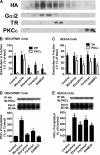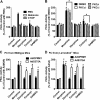Modulating micro-opioid receptor phosphorylation switches agonist-dependent signaling as reflected in PKCepsilon activation and dendritic spine stability
- PMID: 21292762
- PMCID: PMC3069472
- DOI: 10.1074/jbc.M110.177089
Modulating micro-opioid receptor phosphorylation switches agonist-dependent signaling as reflected in PKCepsilon activation and dendritic spine stability
Abstract
A new role of G protein-coupled receptor (GPCR) phosphorylation was demonstrated in the current studies by using the μ-opioid receptor (OPRM1) as a model. Morphine induces a low level of receptor phosphorylation and uses the PKCε pathway to induce ERK phosphorylation and receptor desensitization, whereas etorphine, fentanyl, and [D-Ala2,N-Me-Phe4,Gly5-ol]-enkephalin (DAMGO) induce extensive receptor phosphorylation and use the β-arrestin2 pathway. Blocking OPRM1 phosphorylation (by mutating Ser363, Thr370 and Ser375 to Ala) enabled etorphine, fentanyl, and DAMGO to use the PKCε pathway. This was not due to the decreased recruitment of β-arrestin2 to the receptor signaling complex, because these agonists were unable to use the PKCε pathway when β-arrestin2 was absent. In addition, overexpressing G protein-coupled receptor kinase 2 (GRK2) decreased the ability of morphine to activate PKCε, whereas overexpressing dominant-negative GRK2 enabled etorphine, fentanyl, and DAMGO to activate PKCε. Furthermore, by overexpressing wild-type OPRM1 and a phosphorylation-deficient mutant in primary cultures of hippocampal neurons, we demonstrated that receptor phosphorylation contributes to the differential effects of agonists on dendritic spine stability. Phosphorylation blockage made etorphine, fentanyl, and DAMGO function as morphine in the primary cultures. Therefore, agonist-dependent phosphorylation of GPCR regulates the activation of the PKC pathway and the subsequent responses.
Figures








Similar articles
-
Agonist-dependent mu-opioid receptor signaling can lead to heterologous desensitization.Cell Signal. 2010 Apr;22(4):684-96. doi: 10.1016/j.cellsig.2009.12.003. Epub 2010 Jan 5. Cell Signal. 2010. PMID: 20043990 Free PMC article.
-
Morphine-induced mu-opioid receptor rapid desensitization is independent of receptor phosphorylation and beta-arrestins.Cell Signal. 2008 Sep;20(9):1616-24. doi: 10.1016/j.cellsig.2008.05.004. Epub 2008 May 18. Cell Signal. 2008. PMID: 18558479 Free PMC article.
-
Differences in the characteristics of tolerance to μ-opioid receptor agonists in the colon from wild type and β-arrestin2 knockout mice.Eur J Pharmacol. 2012 Jun 15;685(1-3):133-40. doi: 10.1016/j.ejphar.2012.04.001. Epub 2012 Apr 11. Eur J Pharmacol. 2012. PMID: 22521552 Free PMC article.
-
Mechanisms of rapid opioid receptor desensitization, resensitization and tolerance in brain neurons.Br J Pharmacol. 2012 Mar;165(6):1704-1716. doi: 10.1111/j.1476-5381.2011.01482.x. Br J Pharmacol. 2012. PMID: 21564086 Free PMC article. Review.
-
Agonist-selective mechanisms of GPCR desensitization.Br J Pharmacol. 2008 Mar;153 Suppl 1(Suppl 1):S379-88. doi: 10.1038/sj.bjp.0707604. Epub 2007 Dec 3. Br J Pharmacol. 2008. PMID: 18059321 Free PMC article. Review.
Cited by
-
Opioid receptor desensitization: mechanisms and its link to tolerance.Front Pharmacol. 2014 Dec 18;5:280. doi: 10.3389/fphar.2014.00280. eCollection 2014. Front Pharmacol. 2014. PMID: 25566076 Free PMC article. Review.
-
Decreased Level of Blood MicroRNA-133b in Men with Opioid Use Disorder on Methadone Maintenance Therapy.J Clin Med. 2019 Jul 25;8(8):1105. doi: 10.3390/jcm8081105. J Clin Med. 2019. PMID: 31349687 Free PMC article.
-
Neurod1 modulates opioid antinociceptive tolerance via two distinct mechanisms.Biol Psychiatry. 2014 Nov 15;76(10):775-84. doi: 10.1016/j.biopsych.2014.05.013. Epub 2014 Jun 2. Biol Psychiatry. 2014. PMID: 24993058 Free PMC article.
-
Ligand requirements for involvement of PKCε in synergistic analgesic interactions between spinal μ and δ opioid receptors.Br J Pharmacol. 2015 Jan;172(2):642-53. doi: 10.1111/bph.12774. Epub 2014 Nov 24. Br J Pharmacol. 2015. PMID: 24827408 Free PMC article.
-
Ligand-biased activation of extracellular signal-regulated kinase 1/2 leads to differences in opioid induced antinociception and tolerance.Behav Brain Res. 2016 Feb 1;298(Pt B):17-24. doi: 10.1016/j.bbr.2015.10.032. Epub 2015 Oct 20. Behav Brain Res. 2016. PMID: 26497105 Free PMC article.
References
-
- Urban J. D., Clarke W. P., von Zastrow M., Nichols D. E., Kobilka B., Weinstein H., Javitch J. A., Roth B. L., Christopoulos A., Sexton P. M., Miller K. J., Spedding M., Mailman R. B. (2007) J. Pharmacol. Exp. Ther. 320, 1–13 - PubMed
-
- Violin J. D., Lefkowitz R. J. (2007) Trends Pharmacol. Sci. 28, 416–422 - PubMed
-
- DeWire S. M., Ahn S., Lefkowitz R. J., Shenoy S. K. (2007) Annu. Rev. Physiol. 69, 483–510 - PubMed
-
- Kobayashi H., Narita Y., Nishida M., Kurose H. (2005) Cell Signal. 17, 1248–1253 - PubMed
Publication types
MeSH terms
Substances
Grants and funding
LinkOut - more resources
Full Text Sources
Molecular Biology Databases
Research Materials
Miscellaneous

